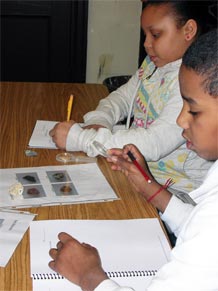What can we learn about rocks by observing them carefully?
2. Explore the rocks

Distribute a tray of materials to each group, but hold back the quartz for now. Write the names of the four rocks on the class chart and pronounce them for the class:
Sandstone … Granite … Conglomerate … Basalt.
Allow a few minutes for students to pass the rocks around and identify each one, then ask students to hold on to whichever rock they have.
Now issue a challenge:
- You have a rock. You have a magnifying glass. You have your senses. Use all your powers of observation to learn everything you can about the rock you are holding.
- List at least six observations about your rock. Write your observations in your notebook. Include some drawings, too.
Have the students work in pairs. Though each student will describe only one rock, comparing the two rocks might elicit more observations.
As you circulate among the groups, draw attention to the different materials the rock is made of.
- Are you talking about the black, bumpy stuff or the white, shiny stuff?
- Is the rock made of the same stuff all the way through?
Make sure students are recording their observations in their notebooks [Observations of a rock], and that they are distinguishing their "data" from their "ideas about data."
Distinguishing "data" from "ideas about data." Help students see the difference between data, which is simply a record of observations, and ideas about data, which include thoughts, questions, predictions, speculations, and hypotheses. “There are sparkly flakes in the rock” is data. “I think the white rock may be heavier than the gray rock.” is a prediction.
Encourage students to record both kinds of information in their notebooks, but to distinguish them in some way. They might put data on one side of the page and ideas and questions on the other. Or they might use colored pencils, and/or a code in the margin: D for Data, I for Idea; Q for Questions.
As the students finish up their observations, recall the investigation question:
What have we learned about rocks so far, just by observing them carefully?



